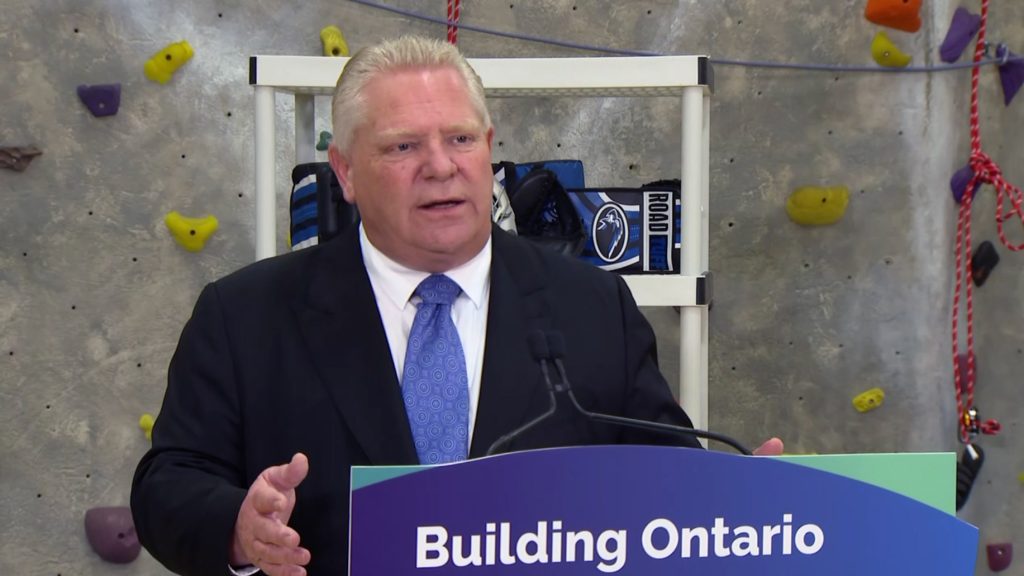Ontario unveils e-learning plan for students amid COVID-19

Posted March 31, 2020 8:42 am.
Last Updated April 1, 2020 5:34 am.
Ontario’s education minister announced Tuesday an e-learning plan for the province’s students during COVID-19 school closures, which will be in effect until at least May 4.
Education Minister Stephen Lecce introduced a new plan to re-established what he described as
“teacher-led learning.”
The plan sets standards for different grade levels, ranging from five hours of work per week for Kindergarten to Grade 6 students and 10 hours of work per week for students in Grades 7 and 8.
High school students will be required to complete three hours of work per course per week for semestered students, with 1.5 hours per course each week for non-semestered students.
Lecce said the plans will incorporate online learning, but where that is not possible, telephone calls and mail-out packages will be used.
The minister said the plan will also require final report cards for all students and prioritize keeping them on track to graduate.
“These are extraordinary times,” Lecce said. “We’re moving quickly with two aims in mind. The first, to keep your child safe, the second is to keep them engaged in learning.”
The president of the Ontario Public School Boards’ Association, which represents trustees, said school boards have been hearing from parents in recent weeks that they need help teaching their children at home.
Cathy Abraham said every board in the province has been crafting a local plan to address the needs of students who may not have access to the internet, computers or tablets, or whose parents may not have time to oversee their schooling.
“This is uncharted territory for everyone,” she said. “We’re just asking parents to have a little bit of patience with their school boards while they try to figure it out. It’s not going to be the same for everybody.”
The director of education at the province’s largest school board told parents Monday night they are developing a plan to connect teachers to students.
The Toronto District School Board’s John Molloy said in the meantime, staff have been trying to determine what devices and internet access families have.
He asked for patience as educators connect with thousands of students to make plans for remote learning.
“As you can appreciate, this is no small task, however we have been working around the clock to ensure that as many students as possible have the opportunity to resume learning remotely next week,” Molloy said in a statement.
The government has formed a working group with the province’s education sector unions to look at options for continued learning until the pandemic abates.
The Elementary Teachers’ Federation of Ontario, which represents 83,000 public school teachers, said in a statement that it supports the temporary moves made to address the situation.
But the union’s president stressed that learning is best done “face-to-face in a classroom setting.”
“We have reminded the ministry that many students have unique and specialized needs and that some have challenging circumstances affecting their ability to engage in learning outside the classroom,” Sam Hammond said in a statement.
“It is extremely important that during this temporary situation, we strive to provide equitable and inclusive opportunities for students to advance their learning.”
The president of the Ontario Secondary School Teachers’ Federation said the union — which represents 60,000 public high school teachers and education workers — will help the government and provide supports to students during this “unprecedented” time.
But Harvey Bischof urged the government to be mindful of students who may struggle with this new approach.
“There needs to be a great deal of flexibility and we need to be very careful not to throw additional hurdles in the way of students who are already face the biggest challenges,” he said. “I don’t want this to exacerbate inequities between students.”
The union representing teachers in the province’s French-language school system said the pandemic is forcing everyone to adapt to an unprecedented situation and the union will work with the government on its plan.
The president of the Ontario English Catholic Teachers’ Association said that union will advocate for a “consistent, provincewide approach” to learning during the closure.
“We will be examining outstanding questions around, for example, privacy, safety, and equity of access to materials and technology,” Liz Stuart said in a statement.
Association des enseignantes et des enseignants franco-ontariens (AEFO) president Remi Sabourin said he is conscious of the socioeconomic and geographic disparities that could limit students’ distance learning.
“The framework of distance learning will evolve as the situation unfolds,” Sabourin said in a statement. “This is a temporary solution. We are well aware that there is no substitute for the direct contact between teacher and students.










